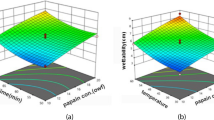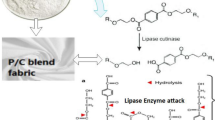Abstract
In this study, the effect of enzymatic hydrolysis using lipase and cutinase on poly(ethyleneterephthalate) (PET) fabrics was investigated in an attempt to improve the hydrophilicity of these fabrics. The hydrolytic activity of the enzymes was expressed for variations in pH levels, temperatures, enzyme concentrations, and treatment times. The effects of using a nonionic surfactant were examined by measuring moisture regain and surface wettability. Finally, the fabric characteristics that were affected by enzyme treatment were evaluated by tensile strength and scanning electron microscopy. The optimal treatment conditions for lipase were determined to be a pH of 4.2, a temperature of 50 °C, a lipase concentration of 100 %, and a treatment time of 90 min; those for cutinase were determined to be a pH of 9.0, a temperature of 50 °C, a cutinase concentration of 100 %, and a treatment time of 60 min. At optimal enzymatic treatment conditions, we got the significant results of increase on the moisture regain and the water contact angle (WCA) and water absorbency effectively decreased. Triton X-100 facilitated cutinase hydrolysis on PET fabrics; however, it was ineffective for lipase. With enzymatic treatment, the tensile strength did not decrease.
Similar content being viewed by others
References
S. Heumann, A. Eberl, H. Pobeheim, S. Liebminger, G. Fischer-Colbrie, E. Almanse, A. Cavalco-Paulo, and G. M. Gübitz, J. Biochem. Biophys. Methods, 39, 89 (2006).
M. A. M. E. Vertommen, V. A. Nierstrasz, M. van der Veer, and M. M. C. G. Warmoeskerken, J. Biotechnol., 120, 376 (2005).
G. Fischer-Colbrie, S. Heumann, S. Liebminger, E. Almanse, A. Cavalco-Paulo, and G. M. Gübitz, Biocatal. Biotransfor., 22, 341 (2004).
H. R. Kim and W. S. Song, Fiber. Polym., 9, 423 (2008).
Y. L. Hsieh and L. A. Cram, Text. Res. J., 68, 311 (1998).
A. Eberl, S. Heumann, R. Kotek, F. Kaufmann, S. Mitsche, A. Cavalco-Paulo, and G. M. Gübitz, J. Biotechnol., 135, 45 (2008).
H. R. Kim and W. S. Song, Fiber. Polym., 7, 339 (2006).
M. Y. Yoon, J. Kellis, and A. J. Poulose, AATCC Review, 2, 33 (2002).
Genencor Int., U. S. Patent, 6254645 (2001).
Novozym®735, Product Information Sheet, Novozymes, 2003.
T. Walter, J. Augusta, R. J. Muller, H. Widdecke, and J. Klein, Enzyme Microb. Tech., 17, 21 (1995).
A. Cavalco-Paulo and G. M. Gübitz, “Textile Processing with Enzymes”, pp.96–191, CRC Press, Washington D.C., 2003.
E. Karapinar and M. O. Sariisik, Fibers Text. East. Eur., 12, 79 (2004).
O. Degani, S. Gepstein, and C. G. Dosoretz, Appl. Biochem. Biotech., 102, 277 (2002).
A. Khoddami, M. Morshed, and H. Tavani, Iran Polym. J., 10, 363 (2001).
Author information
Authors and Affiliations
Corresponding author
Rights and permissions
About this article
Cite this article
Lee, S.H., Song, W.S. Surface modification of polyester fabrics by enzyme treatment. Fibers Polym 11, 54–59 (2010). https://doi.org/10.1007/s12221-010-0054-4
Received:
Revised:
Accepted:
Published:
Issue Date:
DOI: https://doi.org/10.1007/s12221-010-0054-4




